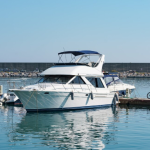Overview of UK Sport Bike Helmet Safety Standards
When discussing UK helmet standards, understanding their evolution is crucial. Over the years, helmet safety regulations in the UK have been enhanced to ensure both riders’ and manufacturers’ compliance. Initially, the focus was on basic protection against impact, but over time, advancements in technology have led to more comprehensive guidelines. These are aimed not just at increasing durability but also at improving overall safety features such as shock absorption and retention systems.
In 2023, new safety regulations were introduced. These not only encompass higher standards for impact resistance but also take into account factors like helmet aerodynamics and weight distribution. Effective compliance with these regulations means that all helmets sold in the UK must pass rigorous testing, ensuring that they provide better protection than previous versions.
Also read : Essential Guidelines for Safely Towing Your Sports Bike on UK Motorways: A Comprehensive Guide
For both riders and manufacturers, adhering to the 2023 helmet guidelines is paramount. Manufacturers must implement state-of-the-art technology and materials to meet these directives. For riders, choosing compliant helmets is essential to maximise safety on the road. With the updated standards, helmet safety in the UK is more robust than ever, marking significant progress in keeping cyclists safer.
Helmet Certification in the UK
Understanding helmet certification is crucial for ensuring safety on the road. In the UK, helmets are typically required to comply with CE standards and ECE 22.05 specifications.
Additional reading : Exploring the Eco Impact: Riding Sport Bikes in Urban UK – Key Environmental Insights
CE marking indicates that a product meets safety, health, and environmental protection standards within the European Economic Area. It’s a visible assurance of quality and reliability, although it is not a sole indicator of helmet safety. CE standards ensure helmets offer basic protection, but they also integrate user comfort and wearability considerations.
ECE 22.05 is a more specific helmet certification requirement aimed at ensuring higher safety standards. Helmets that meet this certification undergo rigorous testing including impact resistance, retention system strength, and field of vision. Each test is designed to simulate real-world scenarios, ensuring the helmet can withstand day-to-day wear and potential accidents.
Testing procedures often include subjecting helmets to a range of impacts to verify they adequately absorb shocks and protect the head. Furthermore, the retention system is checked to guarantee it remains secure during an accident, preventing it from coming off.
Therefore, opting for a helmet with both CE standards and ECE 22.05 certification provides a higher level of safety assurance.
Key Safety Features to Look for in Sport Bike Helmets
When choosing a sport bike helmet, helmet safety features play a crucial role in ensuring your protection and comfort. One of the paramount aspects to consider is the material used for impact protection. High-quality helmets often incorporate advanced protective materials like carbon fibre or polycarbonate, which are designed to disperse energy efficiently during a crash.
In addition to impact protection, comfort is essential for long rides. Comfort technology in helmets often includes ventilation systems, which enhance airflow to keep the rider cool. Look for helmets with adjustable vents that allow you to manage airflow based on riding conditions. Furthermore, internal padding should not only provide cushioning but also be removable and washable to maintain hygiene over time.
Visor clarity is another critical feature. A helmet with an anti-fog and UV-protected visor ensures optimal visibility in various weather conditions. Innovations in helmet technology continue to improve, with features like integrated Bluetooth systems that allow for hands-free communication and navigation.
When selecting a helmet, prioritize these features to ensure a blend of safety, comfort, and functionality for an enhanced riding experience.
Comparison of Popular Sport Bike Helmet Models
When it comes to sport bike helmets, selecting the right model can greatly enhance safety and improve riding experiences. Key brands in the market, like Shoei, Arai, and Bell, consistently offer top-rated helmets with features tailored to both casual riders and avid enthusiasts. Helmet comparisons show that these brands excel in combining cutting-edge technology with comfort.
Shoei is renowned for its precision engineering, often receiving high marks in safety ratings. Models like the Shoei RF-1400 are frequently praised for their aerodynamics and noise reduction features, highly valued by long-distance riders. Arai helmets, on the other hand, are crafted with a focus on maximizing protection and venting systems, making them a favourite for track racers who require optimal airflow.
User reviews reveal that Bell helmets blend affordability with robust features, positioning them as an excellent choice for budget-conscious riders seeking quality without compromise. These differences highlight how rider preferences, such as riding style and budget, are pivotal in determining the most suitable helmet. Understanding these elements ensures you choose a helmet that not only fits your needs but also enhances your safety on the road.
Expert Opinions and Recommendations
Understanding the insights from safety experts within the motorcycle industry can guide wise helmet choices. Experts widely agree that a helmet’s performance is critical in preventing serious injuries. They typically assess helmets based on impact resistance, comfort, and visibility.
When seeking helmet recommendations, experts suggest prioritising standards like DOT, ECE, or SHARP-approved models. These certifications reassure that the helmet undergoes rigorous testing, meeting high safety benchmarks. Experts often highlight helmets with superior aerodynamic designs and anti-fog systems for riders frequently embarking on long journeys.
Case studies provide valuable lessons on helmet effectiveness in real-world scenarios. For instance, helmets that have garnered positive expert reviews often demonstrate excellent performance during controlled tests. These trials mimic impact events, showcasing how certain helmets may better absorb shock, protecting the wearer’s head.
In summary, consulting expert reviews and real-world case studies can guide the selection of helmets that offer both safety endorsements and practical performance benefits. By focusing on expert insights, riders can make informed decisions, maximising protection on the road.
Safety Tips for Riders
Rider safety begins with understanding the importance of wearing helmets. For optimal protection, ensure your helmet fits snugly and is fastened securely. Regularly practicing safety practices includes inspecting your helmet for visible damage such as cracks or missing padding. Any indication of wear can compromise its protective capabilities.
Helmet maintenance is crucial. Frequent checks for dents, loose parts, or fraying straps can prevent accidents. A poorly maintained helmet might not provide the necessary safety in the event of a fall or collision. It’s advisable to replace helmets every three to five years, as the materials can degrade over time.
Finally, using non-compliant helmets poses significant risks. These helmets might not meet safety standards, leaving you exposed to potential injuries. Educating riders on this danger encourages informed decisions, preventing unnecessary accidents. By adhering to these guidelines, riders can maximize their safety on the road.
Resources for Further Information
Finding reliable safety resources is essential for ensuring helmet effectiveness. In the UK, several official organizations establish comprehensive safety standards. Regulatory bodies like the British Standards Institution (BSI) and the Transport Research Laboratory (TRL) offer guidelines to ensure helmets meet the required safety criteria. Consumers can access valuable helmet information through these bodies to verify compliance.
For those interested in more technical details, research papers and industry reports provide insights into recent advancements in helmet technology. These publications often cover new materials and design improvements, aligning safety with comfort and efficiency.
When purchasing a helmet, ensuring it meets the standards set by regulatory bodies can prevent potential safety risks. Many of these organizations have online databases or downloadable resources, making it easy for consumers to check helmet compliance before making a purchase. For deeper understanding, supplementary literature focuses on the evolving landscape of head protection, shedding light on both established methodologies and innovative breakthroughs in the field.
By staying informed through these trusted sources, consumers can better navigate the choices available in the helmet market, ensuring a blend of protection and comfort.













